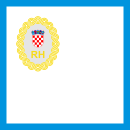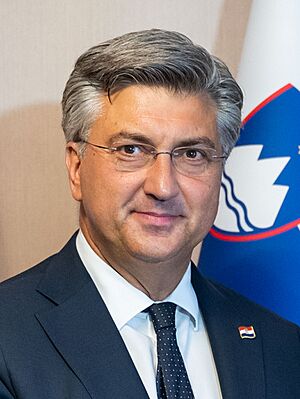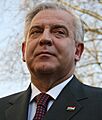Prime Minister of Croatia facts for kids
Quick facts for kids President of the Government of the Republic of Croatia |
|
|---|---|

|
|
| Government of Croatia Office of the President of the Government |
|
| Style |
|
| Member of |
|
| Reports to | Croatian Parliament |
| Seat | Banski Dvori, Trg sv. Marka 2, Zagreb, Croatia |
| Nominator | President of Croatia |
| Appointer | Croatian Parliament |
| Term length | At the pleasure of the parliamentary majority. Parliamentary elections must be held no later than 60 days after the expiration of a full parliamentary term of 4 years, but an incumbent prime minister shall remain in office in a caretaker capacity until a new government is confirmed in Parliament and sworn in by its speaker. |
| Constituting instrument | Constitution of Croatia |
| Inaugural holder | Stjepan Mesić (after adoption of constitutional Amendment LXXIII) Josip Manolić (under current Constitution) |
| Formation | 25 July 1990 (by constitutional Amendment LXXIII) 22 December 1990 (under current Constitution) |
| Deputy | Deputy Prime Minister (position held by one or more members of the government) |
| Salary | €66 400 yearly |
The prime minister of Croatia, officially called the president of the government of the Republic of Croatia, is the main leader of the government in Croatia. This person is usually the most powerful and important official in the Croatian government system.
Even though the prime minister is very powerful, the president of Croatia and the speaker of the Parliament are formally ranked higher. The prime minister's office was first created in 1945. Between 1990 and 2000, Croatia had a "semi-presidential" system, which meant the president had more power. But since 2000, the prime minister has become the most important leader again.
The Constitution of Croatia explains that the Parliament watches over the Government. It also says that the President makes sure the government works well. The current prime minister of Croatia is Andrej Plenković. The Croatian government meets in a historic building called Banski dvori in Zagreb.
Contents
What is the Prime Minister's Official Name?
The official name for the prime minister in Croatia is "President of the Government." In Croatian, this is Predsjednik / Predsjednica Vlade. People also often use the shorter term Premijer / Premijerka, which means "Premier."
A Brief History of the Role
Early Leaders of Croatia
Before Croatia became fully independent, it was part of larger states. From 1868 to 1918, when it was the Kingdom of Croatia-Slavonia, the leader was called the Ban of Croatia. This person represented the King.
Later, when Croatia was a republic within Federal People's Republic of Yugoslavia, the first head of government was Vladimir Bakarić, starting in 1945. At that time, this role was very powerful, along with the leader of the Communist Party. In 1952, the title changed to President of the Executive Council. It's interesting to note that Savka Dabčević-Kučar was the first woman in Europe to hold a position like a head of government, serving from 1967 to 1969.
Becoming an Independent Nation
In 1990, Croatia held its first multi-party elections. At this time, it was still part of Yugoslavia. Stjepan Mesić became the President of the Executive Council on May 30, 1990.
On July 25, 1990, the new Croatian Parliament made important changes to the constitution. They removed old socialist references and adopted new national symbols. This is when the Government of the Republic of Croatia was officially created.
More big changes happened on December 22, 1990, with the "Christmas Constitution." This constitution set up the Republic of Croatia and its government. From this point, Croatia became a "semi-presidential republic." This meant the president of Croatia had a lot of power, including choosing and removing the prime minister.
After a vote in May 1991 where most people wanted independence, Croatia officially declared itself independent from Yugoslavia on June 25, 1991. Josip Manolić continued as prime minister. However, Croatia then agreed to pause its independence efforts for a short time. During this period, the Croatian War of Independence began. Franjo Gregurić was appointed to lead a special "Government of National Unity." In October 1991, Croatia finally cut all ties with Yugoslavia.
Croatia's Prime Ministers Since Independence
Between 1990 and 2000, Croatia had seven different prime ministers.
After the elections in January 2000, the winning political parties changed the Constitution again. They took away most of the President's executive powers and gave more power to the Parliament and the prime minister. This made Croatia a "parliamentary republic," and the prime minister once again became the most important political figure.
As of 2022, Croatia has had twelve prime ministers who have led 14 governments since the first multi-party elections. Most of them were from the Croatian Democratic Union party, two were from the Social Democratic Party of Croatia, and one was not part of any political party. Only one woman has served as prime minister since independence: Jadranka Kosor.
Who Are the Prime Ministers?
Here is a list of the prime ministers of Croatia since it began its journey to independence:
- Stjepan Mesić (May 30, 1990 – August 24, 1990)
- Josip Manolić (August 24, 1990 – July 17, 1991)
- Franjo Gregurić (July 17, 1991 – August 12, 1992)
- Hrvoje Šarinić (August 12, 1992 – April 3, 1993)
- Nikica Valentić (April 3, 1993 – November 7, 1995)
- Zlatko Mateša (November 7, 1995 – January 27, 2000)
- Ivica Račan (January 27, 2000 – December 23, 2003)
- Ivo Sanader (December 23, 2003 – July 6, 2009)
- Jadranka Kosor (July 6, 2009 – December 23, 2011) - She was the first and only female prime minister.
- Zoran Milanović (December 23, 2011 – January 22, 2016)
- Tihomir Orešković (January 22, 2016 – October 19, 2016)
- Andrej Plenković (October 19, 2016 – present) - He is the current prime minister.
Images for kids
See also
 In Spanish: Primer ministro de Croacia para niños
In Spanish: Primer ministro de Croacia para niños
- List of cabinets of Croatia
- President of Croatia
- Speaker of the Croatian Parliament
- Politics of Croatia














